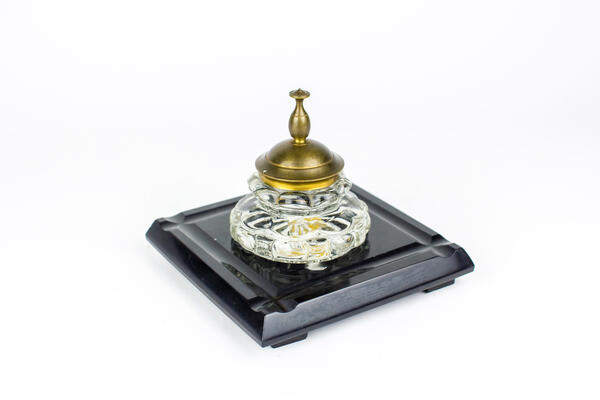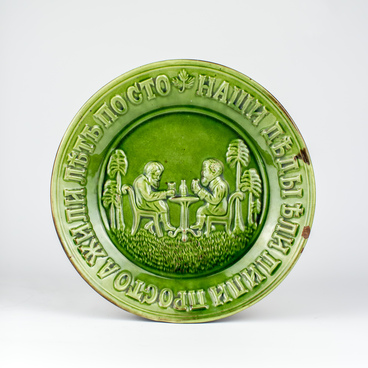In the good old days, an inkstand consisted of several writing instruments, which were made in the same style from the same materials. It always included an inkstand base and an inkpot. Besides them, an inkpot set could include a presse-buvard (a special paperweight with blotting paper), a penholder, a pen wiper, an ashtray, a matchbox, a paper clip dispenser and even a lamp with a lampshade. An inkpot set might have included a jar of sand that was sprinkled on the written text to soak up excess ink.
Archaeologists consider a clay vessel, found during excavations in the Roman city of Herculaneum on the coast of the Bay of Naples, to be the prototype of the inkpot. At the bottom of the vessel was dried “ink” that is basically was soot diluted in oil.
In ancient times, any suitable vessel could be used as an inkpot: a clay flask, a horn inserted into a lid of a table, apothecary vials. However, more often a vessel for ink was specially made, giving it a convenient form — a cylinder, a cube, a jug or a glass.
In the Middle Ages inkstands were made of leather, horns and metal. Englishmen first produced more common glass inkpots. English artisans managed to develop so called “safe” inkpots. Their neck was furnished with special cone-shaped funnel, which prevented ink from spilling even if the vessel was tipped over.
The courtiers of royal palaces first used desktop writing sets. They consisted only of an inkpot and a goose quill. Ink jars were made to order, richly decorated, for example, incrusted with precious stones.
Inkstands were made of white or gray monolithic marble, colored and mottled marble-like limestone, wood. The base of the inkstand was usually rectangular and had a groove for pens and sockets for inkpots on its surface. It was often decorated with sculptural details such as animal figures or portraits of famous personalities.
In the Russian Empire, mass production of inkpots was practiced not only by numerous bronze foundries, but also by large jewelry firms, which were awarded the title of Suppliers to the Imperial Court — the Sazikov firm, the Ovchinnikov factory, the Khlebnikov factory, the Grachev brothers factory, the Fabergé firm.
Archaeologists consider a clay vessel, found during excavations in the Roman city of Herculaneum on the coast of the Bay of Naples, to be the prototype of the inkpot. At the bottom of the vessel was dried “ink” that is basically was soot diluted in oil.
In ancient times, any suitable vessel could be used as an inkpot: a clay flask, a horn inserted into a lid of a table, apothecary vials. However, more often a vessel for ink was specially made, giving it a convenient form — a cylinder, a cube, a jug or a glass.
In the Middle Ages inkstands were made of leather, horns and metal. Englishmen first produced more common glass inkpots. English artisans managed to develop so called “safe” inkpots. Their neck was furnished with special cone-shaped funnel, which prevented ink from spilling even if the vessel was tipped over.
The courtiers of royal palaces first used desktop writing sets. They consisted only of an inkpot and a goose quill. Ink jars were made to order, richly decorated, for example, incrusted with precious stones.
Inkstands were made of white or gray monolithic marble, colored and mottled marble-like limestone, wood. The base of the inkstand was usually rectangular and had a groove for pens and sockets for inkpots on its surface. It was often decorated with sculptural details such as animal figures or portraits of famous personalities.
In the Russian Empire, mass production of inkpots was practiced not only by numerous bronze foundries, but also by large jewelry firms, which were awarded the title of Suppliers to the Imperial Court — the Sazikov firm, the Ovchinnikov factory, the Khlebnikov factory, the Grachev brothers factory, the Fabergé firm.


